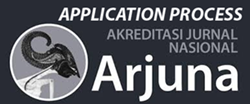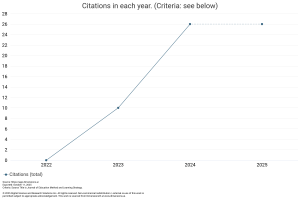Development of Audio Visual Learning Media Based on Canva Application for Class VII Subject of Society at SMP Negeri 6 Sigi
DOI:
https://doi.org/10.59653/jemls.v2i02.721Keywords:
Audio Visual, Media, Canva, Education Method, Learning StrategyAbstract
The important role of education is to improve the quality of human resources through effective, efficient and enjoyable learning, so that students are able to absorb information optimally. The media used in learning has not maximized technological developments so that a contextual, creative and collaborative learning experience has not been achieved. This research aims to produce Canva-based audio visual learning media. This type of research uses Research and Development (R&) with the ADDIE (Analysis, Design, Development, Implementation, and Evaluation) development model. The subject of this research is the development of audio visual learning media based on the Canva application for class VII A students, totaling 30 students in one class. The data collection technique used in this research was carried out using an expert questionnaire consisting of material experts, media experts, and a questionnaire sheet on student responses to the learning media being developed. The research results showed that the feasibility of Canva-based audio visual learning media was assessed by one media expert and a material expert. Based on the assessment, the results obtained from material experts were 95% and included in the very feasible category, while those from media experts were 74.30% and included in the feasible category. Overall, media can be used for the learning process.
Downloads
References
Afifulloh, M., & Sulistiono, M. (2023). Strengthening Digital Literacy through Creating Audio Visual Learning Media. Wikrama Parahita: Journal of Community Service , 7 (2), 211–216. https://doi.org/10.30656/jpmwp.v7i2.5346
Diah Verra Ninda, Riski Ananda, Dzil Ilman Azra, Sukatin, & Pahmi. (2022). Developing Teacher Teaching Skills Based on Islamic Religious Education Values. Pedagogika: Journal of Educational Sciences , 2 (2), 138–150. https://doi.org/10.57251/ped.v2i2.711
Hamzah Pagarra, Ahmad Syawaluddin, WK & S. (2022). LEARNING MEDIA (Pe Print). UNM Publishing Agency.
Hasan, MMDHKT (2021). Instructional Media. In Tahta Media Group (May Issue).
Hidayat, B. (2020). Historical Overview of Social Sciences Education in Indonesia. Indonesian Journal of Social Sciences Education , 4 (2), 147–154. https://doi.org/10.23887/pips.v4i2.3493
Khoirurrijal, Fadriati, Sofia, Anisa Dwi Makrufi, Sunaryo Gandi, Abdul Muin, T., & Ali Fakhrudin, Hamdani, S. (2022). DEVELOPMENT OF THE INDEPENDENT CURRICULUM (Rosyiful Aqli, Ed.). CV. Eternal Archipelago Literacy.
Purba, YA, & Harahap, A. (2022). Utilization of the Canva Application as a Mathematics Learning Media at SMPN 1 NA IX-X Aek, Batu City. Scholar's Journal: Journal of Mathematics Education , 6 (2), 1325–1334. https://doi.org/10.31004/cendekia.v6i2.1335
Sanulita, H., Hendriyanto, D., Citrawati Lestari, N., Ramli, A., & Arifudin, O. (2024). Analysis Of The Effectiveness Of Audio Visual Learning Media Based On Macromedia Flash Usage On School Program Of Increasing Student Learning Motivation. Journal on Education , 6 (2), 12641–12650. https://doi.org/10.31004/joe.v6i2.5121
Sompito, M. (2021). Efforts to Form Students' Character Through the Development of Social and Emotional Religious Values at Alwildan Kindergarten Manado. Indonesian Journal of Early Childhood Education (IJECE) , 1 (01), 1–15. https://doi.org/10.30984/ijece.v1i01.105
Supriadi Juraid Abdul; Mishnah, Mishnah; Mahfud, Mahfud, ML (2020). Development of Environmentally Based Teaching Materials to Shape Student Character in Social Sciences Subjects at SMP Negeri 5 Model Palu, Central Sulawesi. Online Creative Journal , 8 (Vol 8, No 2 (2020): Online Creative Journal), 133–140.
Waruwu, M. (2023). Educational Research Approaches: Qualitative Research Methods, Quantitative Research Methods and Combination Research Methods . 7 .
Wijaya, A., Akhbar, T., & Dedy, A. (2023). Development of Audio Visual Learning Media Using Sparkol Video Scribe in Social Sciences Subjects at SD Negeri 235 Palembang . 7 .
Downloads
Published
How to Cite
Issue
Section
License
Copyright (c) 2024 Ferdi Bumbungan, Juraid, Misnah

This work is licensed under a Creative Commons Attribution-ShareAlike 4.0 International License.
Authors who publish with this journal agree to the following terms:
- Authors retain copyright and grant the journal right of first publication with the work simultaneously licensed under a Creative Commons Attribution-ShareAlike that allows others to share the work with an acknowledgement of the work's authorship and initial publication in this journal.
- Authors are able to enter into separate, additional contractual arrangements for the non-exclusive distribution of the journal's published version of the work (e.g., post it to an institutional repository or publish it in a book), with an acknowledgement of its initial publication in this journal.
- Authors are permitted and encouraged to post their work online (e.g., in institutional repositories or on their website) prior to and during the submission process, as it can lead to productive exchanges, as well as earlier and greater citation of published work (See The Effect of Open Access).
























